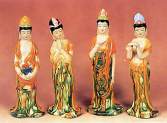| What are specials of Tang Sancai? Tang SanCai items that have been unearthed include horses, humans, and even pillows, and camels, of which the pottery camel is one of the best. Its head rises high, as if telling stories about merchant caravans along the Silk Road in the remote past and the prosperity of the Tang Dynasty. Being the gem of ancient Chinese art, Tang San Cai absorbed the advantages
| 
|
of Chinese painting, sculpture and stone carving. It features fleshy figures, regular and exquisite techniques, compact carving traces, and smooth lines, indicating the high-level of the craft reached in the Tang Dynasty. Tang San Cai is mainly divided into pottery tomb-figures and daily commodities. Most of the tri-color human figures are female. They range in size from a dozen centimeters to over one meter tall, and wear gorgeous, fashionable costumes whilst emanating grace and refinement. Their full figure and round face are in conformity with the criteria of beauty in the Tang Dynasty. Human figures also include depictions of Hu people (a general term for people of non-Han origin), which make them a unique feature of the Tang Dynasty. |